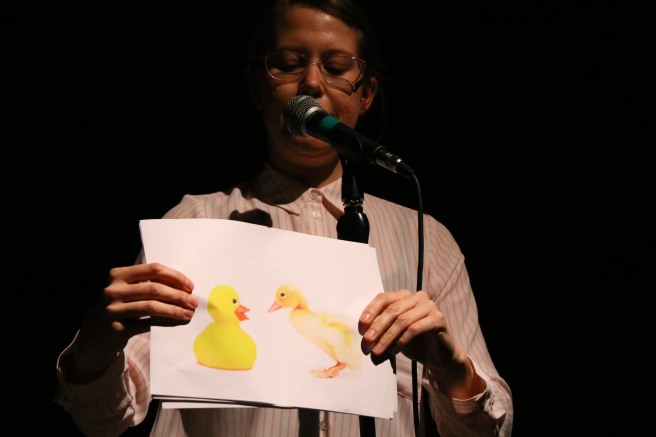By Dr. Kate Antosik-Parsons, Research Associate UCD Humanities Institute
EL Putnam’s captivating artworks of performance, sound, video and interactive digital technologies interrogate citizenship and social responsibility and explore materiality while considering gender and sexuality from multiple perspectives. […] Originally from the United States, Putnam’s move to Ireland in 2013 saw the themes present in her work incorporate insightful observations on the historical, political and cultural specificities of Ireland. This has been underscored by her experiences of becoming a mother in Ireland, resulting in motherhood, the act of mothering and maternal subjectivity emerging as critical points of engagement.
[…]

Fertile Ground (2017) was an intriguingly nuanced live art work composed of different media that entwined multiple perspectives of motherhood with embodied actions and deftly woven symbolism. Throughout the performance the artist held an object, the particulars of which emerged as the work progressed. A ‘pomegranate’, it was a medium-sized circular wooden embroidery hoop covered with black cloth onto which was a series of thin, stainless steel conductive thread and motion sensor LEDs were sewn. Sensing movements of Putnam’s body imperceptible to the viewer, the LEDs responded by translating these movements into different patterns of red, orange and white lights. The effect was hypnotic, particularly as the initial depravation of sight in the darkened gallery left one longing for the reassurance of visual information.
Putnam’s artistic practice juxtaposes traditional crafts with cutting edge digital technology. A skill learned from her mother, knitting was an important element in Status (2009), Doll Games (2010) and Deferral II (2011), as the historically gendered craft was used to explore different aspects of futility by creating and later unravelling knots of exaggerated sizes or large chains of I-cords. Knitting reemerged more recently in Enough Rope (2015), as Putnam wore a knitted harness that responded to the movements of her lower body in a live performance that examined the complexities of mothering in a foreign culture. In Fertile Ground, the use of ‘wearable electronics’ replaced the tactile yarn with a Flora microcontroller and motion sensor LEDs embedded into fabric. Despite incorporating seemingly disparate media, her work renders visible underlying similarities between the two, specifically in terms of process. Both knitting by pattern and using online DIY guides to programme wearable electronics rely on the experiential aspect of knowledge. In Putnam’s work this resulted in an embodied knowledge that held significant potential in terms of how ‘sensory’ information is received and transmitted from the maternal body to the viewer.

In Fertile Ground light, quite literally, illuminated an important figure ground relationship that shifted over the course of the performance. In composing an artwork, the perception of the figure against the ground is reliant on distinguishing the subject from the background. Ambiguity occurs when the figure cannot be clearly demarcated from background, opening up a possibility of multiple viewpoints. Although live art usually incorporates different modes of relationality, in Fertile Ground, the figure ground ambiguity, a result of the artist’s black clothing and the darkened space, initially produced anxiety. As the video projected against the wall increasingly delineated the body of the artist, the initial ambiguity dissolved. However, it then became apparent that her figure had split in two, for cast behind her was her shadow, an Other. The splitting of the self resonates with the ways in which Fertile Ground explore the multiple perspectives offered on the relationship between mother and daughter throughout the performance. In a sense, the figure ground relationship became the fertile ground upon which the dialogues of reproduction, maternity and the mother-child relationship are entrenched.
The passage of time was signified by the clicking sound of the metronome, a rhythmic replication of a heartbeat. Coupled with Putman’s calls of ‘cuckoo’, it referenced a cuckoo clock. In the context of maternal subjectivity, it was reminiscent of the different temporalities mothers experience, and when combined with the projected video and LED pomegranate, it signified pregnancy, namely the gestational development from fertilised egg to birth. In Greek mythology, the cuckoo is a symbol of virginal Hera who was tricked into a relationship with Zeus when he adopted the guise of a cuckoo. Though goddess of marriage and childbirth, Hera’s spiteful and duplicitous actions against Zeus’s numerous children from different mothers rendered her a flawed maternal figure. Interestingly, the common cuckoo is also a troubling maternal figure for it is a brood parasite; it slyly lays its eggs in the nests of other species for host parents to raise. The cuckoo hatchlings, often larger than the hosts’ own young, require greater portions of food to the detriment of other hatchlings, who are thrown from the nest if the cuckoo’s demands are not met.[1] The connections between the unseemly maternal figures of Hera and the cuckoo are interesting in terms of the ways in which Irish society historically categorized women, separating those who were, or indeed, would become, ‘suitable’ mothers from those society deemed ‘unfit’, for example unwed women who were punished for their perceived sexual transgressions to maternity homes known as Mother and Baby homes, where their children were adopted often without consent, or incarcerated in Magdalene Laundries. Fertile Ground highlighted the complicated entanglements of maternal subjectivity while serving to subvert idealized tropes of motherhood that construct the cultural norm.
[1] Stevens, Martin. (2013) “Bird Brood Parasitism.” Current Biology, Vol. 23. Issue 20. http://www.sciencedirect.com/science/article/pii/S0960982213010312
EL Putnam presented Fertile Ground as part of “Fertile Ground” at Fumbally Exchange in Dublin, April 2017, curated by Ciara McKeon. Photography by Fiona Killeen (www.blueprintphotography.ie).








